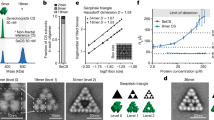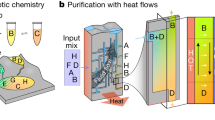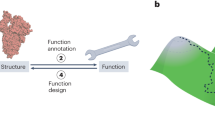Abstract
Engineered metabolic pathways constructed from enzymes heterologous to the production host often suffer from flux imbalances, as they typically lack the regulatory mechanisms characteristic of natural metabolism. In an attempt to increase the effective concentration of each component of a pathway of interest, we built synthetic protein scaffolds that spatially recruit metabolic enzymes in a designable manner. Scaffolds bearing interaction domains from metazoan signaling proteins specifically accrue pathway enzymes tagged with their cognate peptide ligands. The natural modularity of these domains enabled us to optimize the stoichiometry of three mevalonate biosynthetic enzymes recruited to a synthetic complex and thereby achieve 77-fold improvement in product titer with low enzyme expression and reduced metabolic load. One of the same scaffolds was used to triple the yield of glucaric acid, despite high titers (0.5 g/l) without the synthetic complex. These strategies should prove generalizeable to other metabolic pathways and programmable for fine-tuning pathway flux.
This is a preview of subscription content, access via your institution
Access options
Subscribe to this journal
Receive 12 print issues and online access
$209.00 per year
only $17.42 per issue
Buy this article
- Purchase on Springer Link
- Instant access to full article PDF
Prices may be subject to local taxes which are calculated during checkout






Similar content being viewed by others
References
Stephanopoulos, G. Challenges in engineering microbes for biofuels production. Science 315, 801–804 (2007).
Nakamura, C.E. & Whited, G.M. Metabolic engineering for the microbial production of 1,3-propanediol. Curr. Opin. Biotechnol. 14, 454–459 (2003).
Khosla, C. & Keasling, J.D. Metabolic engineering for drug discovery and development. Nat. Rev. Drug Discov. 2, 1019–1025 (2003).
Harcum, S.W. & Bentley, W.E. Heat-shock and stringent responses have overlapping protease activity in Escherichia coli. Implications for heterologous protein yield. Appl. Biochem. Biotechnol. 80, 23–37 (1999).
Kizer, L., Pitera, D.J., Pfleger, B. & Keasling, J.D. Functional genomics for pathway optimization: application to isoprenoid production. Appl. Environ. Microbiol 74, 3229–3241 (2008).
Zhu, M.M., Lawman, P.D. & Cameron, D.C. Improving 1,3-propanediol production from glycerol in a metabolically engineered Escherichia coli by reducing accumulation of sn-glycerol-3-phosphate. Biotechnol. Prog. 18, 694–699 (2002).
Barbirato, F., Grivet, J.P., Soucaille, P. & Bories, A. 3-Hydroxypropionaldehyde, an inhibitory metabolite of glycerol fermentation to 1,3-propanediol by enterobacterial species. Appl. Environ. Microbiol. 62, 1448–1451 (1996).
Stephanopoulos, G. Metabolic fluxes and metabolic engineering. Metab. Eng. 1, 1–11 (1999).
Pitera, D.J., Paddon, C.J., Newman, J.D. & Keasling, J.D. Balancing a heterologous mevalonate pathway for improved isoprenoid production in. Escherichia coli. Metab. Eng. 9, 193–207 (2007).
Pfleger, B.F., Pitera, D.J., Smolke, C.D. & Keasling, J.D. Combinatorial engineering of intergenic regions in operons tunes expression of multiple genes. Nat. Biotechnol. 24, 1027–1032 (2006).
Bloom, J.D. et al. Evolving strategies for enzyme engineering. Curr. Opin. Struct. Biol. 15, 447–452 (2005).
Miles, E.W., Rhee, S. & Davies, D.R. The molecular basis of substrate channeling. J. Biol. Chem. 274, 12193–12196 (1999).
Spivey, H.O. & Ovadi, J. Substrate channeling. Methods 19, 306–321 (1999).
Hyde, C.C., Ahmed, S.A., Padlan, E.A., Miles, E.W. & Davies, D.R. Three-dimensional structure of the tryptophan synthase alpha 2 beta 2 multienzyme complex from Salmonella typhimurium. J. Biol. Chem. 263, 17857–17871 (1988).
Thoden, J.B., Holden, H.M., Wesenberg, G., Raushel, F.M. & Rayment, I. Structure of carbamoyl phosphate synthetase: a journey of 96 A from substrate to product. Biochemistry 36, 6305–6316 (1997).
Conrado, R.J., Varner, J.D. & DeLisa, M.P. Engineering the spatial organization of metabolic enzymes: mimicking nature's synergy. Curr. Opin. Biotechnol. 19, 492–499 (2008).
Mosbach, K. & Mattiasson, B. Matrix-bound enzymes. II. Studies on a matrix-bound two-enzyme-system. Acta Chem. Scand. 24, 2093–2100 (1970).
Bulow, L. Characterization of an artificial bifunctional enzyme, beta-galactosidase/galactokinase, prepared by gene fusion. Eur. J. Biochem. 163, 443–448 (1987).
Bulow, L., Ljungcrantz, P. & Mosbach, K. Preparation of a soluble biofunctional enzyme by gene fusion. Bio/Technology 3, 821–823 (1985).
Martin, V.J., Pitera, D.J., Withers, S.T., Newman, J.D. & Keasling, J.D. Engineering a mevalonate pathway in Escherichia coli for production of terpenoids. Nat. Biotechnol. 21, 796–802 (2003).
Nagar, B. et al. Structural basis for the autoinhibition of c-Abl tyrosine kinase. Cell 112, 859–871 (2003).
Prehoda, K.E., Scott, J.A., Mullins, R.D. & Lim, W.A. Integration of multiple signals through cooperative regulation of the N-WASP-Arp2/3 complex. Science 290, 801–806 (2000).
Dueber, J.E., Yeh, B.J., Bhattacharyya, R.P. & Lim, W.A. Rewiring cell signaling: the logic and plasticity of eukaryotic protein circuitry. Curr. Opin. Struct. Biol. 14, 690–699 (2004).
Dueber, J.E., Yeh, B.J., Chak, K. & Lim, W.A. Reprogramming control of an allosteric signaling switch through modular recombination. Science 301, 1904–1908 (2003).
Dueber, J.E., Mirsky, E.A. & Lim, W.A. Engineering synthetic signaling proteins with ultrasensitive input/output control. Nat. Biotechnol. 25, 660–662 (2007).
Levchenko, A., Bruck, J. & Sternberg, P.W. Scaffold proteins may biphasically affect the levels of mitogen-activated protein kinase signaling and reduce its threshold properties. Proc. Natl. Acad. Sci. USA 97, 5818–5823 (2000).
Werpy, T. & Petersen, G. Top value added chemicals from biomass. vol. I: Results of screening for potential candidates from sugars and synthesis gas (US Dept. of Energy, Oak Ridge, Tennessee and Dept. of Commerce, Springfield, Virginia; 2004). 〈http://www.pnl.gov/main/publications/external/technical_reports/PNNL-14808.pdf〉.
Moon, T.S., Yoon, S.H., Lanza, A.M., Roy-Mayhew, J.D. & Prather, K.L. Production of glucaric acid from a synthetic pathway in recombinant Escherichia coli. Appl. Environ. Microbiol. 75, 589–595 (2009).
Elowitz, M.B. & Leibler, S. A synthetic oscillatory network of transcriptional regulators. Nature 403, 335–338 (2000).
Gardner, T.S., Cantor, C.R. & Collins, J.J. Construction of a genetic toggle switch in Escherichia coli. Nature 403, 339–342 (2000).
Bashor, C.J., Helman, N.C., Yan, S. & Lim, W.A. Using engineered scaffold interactions to reshape MAP kinase pathway signaling dynamics. Science 319, 1539–1543 (2008).
Howard, P.L., Chia, M.C., Del Rizzo, S., Liu, F.F. & Pawson, T. Redirecting tyrosine kinase signaling to an apoptotic caspase pathway through chimeric adaptor proteins. Proc. Natl. Acad. Sci. USA 100, 11267–11272 (2003).
Yeh, B.J., Rutigliano, R.J., Deb, A., Bar-Sagi, D. & Lim, W.A. Rewiring cellular morphology pathways with synthetic guanine nucleotide exchange factors. Nature 447, 596–600 (2007).
Lee, S.K., Newman, J.D. & Keasling, J.D. Catabolite repression of the propionate catabolic genes in Escherichia coli and Salmonella enterica: evidence for involvement of the cyclic AMP receptor protein. J. Bacteriol. 187, 2793–2800 (2005).
Shetty, R.P., Endy, D. & Knight, T.F. Jr. Engineering BioBrick vectors from BioBrick parts. J. Biol. Eng. 2, 5 (2008).
Hillier, B.J., Christopherson, K.S., Prehoda, K.E., Bredt, D.S. & Lim, W.A. Unexpected modes of PDZ domain scaffolding revealed by structure of nNOS-syntrophin complex. Science 284, 812–815 (1999).
Khlebnikov, A., Datsenko, K.A., Skaug, T., Wanner, B.L. & Keasling, J.D. Homogeneous expression of the P(BAD) promoter in Escherichia coli by constitutive expression of the low-affinity high-capacity AraE transporter. Microbiology 147, 3241–3247 (2001).
Shevchenko, A., Tomas, H., Havlis, J., Olsen, J.V. & Mann, M. In-gel digestion for mass spectrometric characterization of proteins and proteomes. Nat. Protocols 1, 2856–2860 (2006).
Acknowledgements
We thank A. Arkin, J. Dietrich, E. Dueber, L. Katz, and W. Whitaker for comments and discussion during the preparation of the manuscript. We also thank members of the Dueber and Keasling labs for experimental help and discussions. This work was supported by funding from UC Berkeley QB3 Institute (J.E.D.), National Science Foundation (NSF) Synthetic Biology Engineering Research Center grant no. EEC-0540879 (J.E.D., J.D.K, K.L.J.P., T.S.M.), NSF grant no. CBET-0756801 (J.E.D.), the Bill and Melinda Gates Foundation (J.D.K), Joint BioEnergy Institute (J.D.K.), the Office of Naval Research Young Investigator Program grant no. N000140510656 (K.L.J.P. and T.S.M.).
Author information
Authors and Affiliations
Contributions
J.E.D. conceived the project, designed all experiments and wrote the manuscript. J.E.D. and G.C.W. co-performed the experiments, and G.C.W. edited the manuscript. G.R.M. constructed and performed preliminary experiments used as a foundation for experiments included in this paper. T.S.M. contributed an experimental role for glucaric acid pathway experiments and edited the manuscript. C.J.P. contributed an experimental role for mass spectrometry experiments. A.V.U. contributed a supportive role in performing experiments for Supplementary Information Materials. K.L.J.P. contributed in development of the glucaric acid pathway and edited the manuscript. J.D.K. contributed general advice, especially with the mevalonate biosynthesis pathway, resource support and critical advice for manuscript preparation.
Corresponding author
Ethics declarations
Competing interests
Jay Keasling has a financial interest in Amyris and LS9.
Supplementary information
Supplementary Text and Figures
Supplementary Figures 1–8 and Supplementary Tables 1–8 (PDF 861 kb)
Rights and permissions
About this article
Cite this article
Dueber, J., Wu, G., Malmirchegini, G. et al. Synthetic protein scaffolds provide modular control over metabolic flux. Nat Biotechnol 27, 753–759 (2009). https://doi.org/10.1038/nbt.1557
Received:
Accepted:
Published:
Issue Date:
DOI: https://doi.org/10.1038/nbt.1557
This article is cited by
-
DNA scaffold assisted ectoine production in Escherichia coli
Systems Microbiology and Biomanufacturing (2024)
-
Strategies for the biological synthesis of D-glucuronic acid and its derivatives
World Journal of Microbiology and Biotechnology (2024)
-
Production of d-glucaric acid with phosphoglucose isomerase-deficient Saccharomyces cerevisiae
Biotechnology Letters (2024)
-
Engineered Saccharomyces cerevisiae for de novo δ-tocotrienol biosynthesis
Systems Microbiology and Biomanufacturing (2024)
-
Engineering Bacillus subtilis for efficient production of 3′-sialyllactose
Systems Microbiology and Biomanufacturing (2024)



